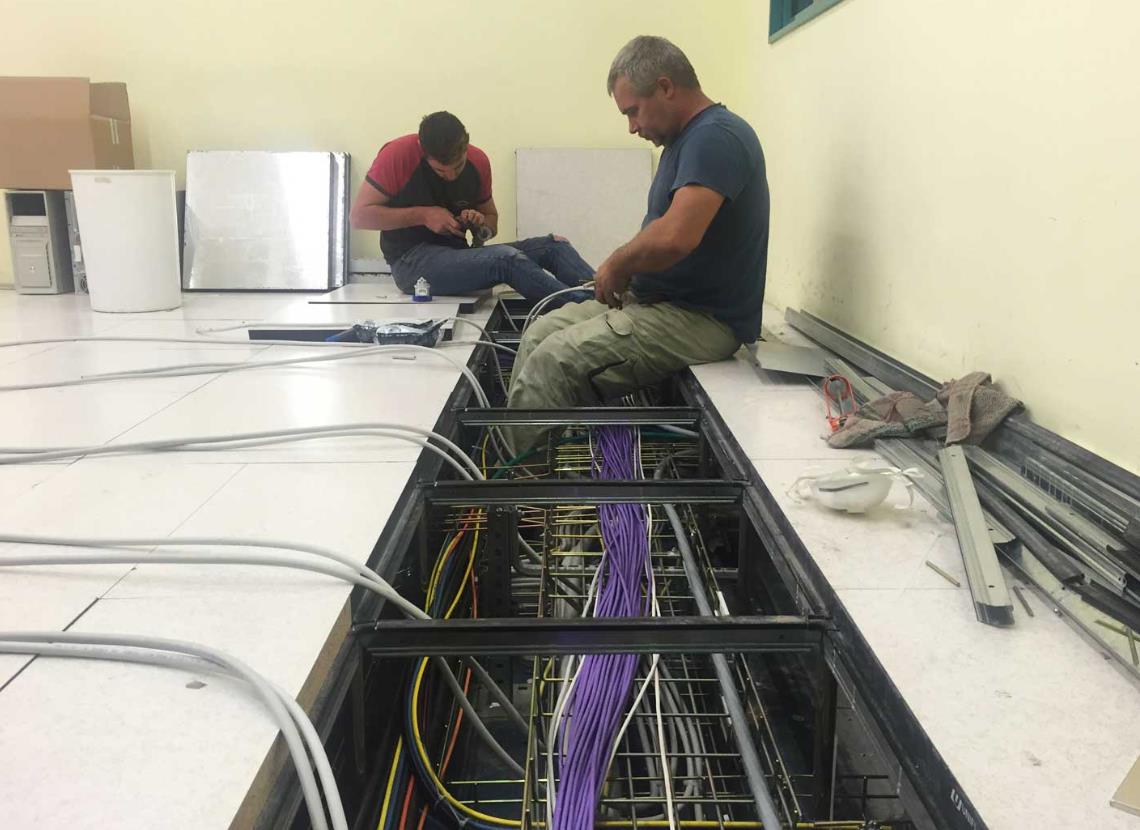Data Center Raised Floor

Committed to providing top-quality raised floor installation services, Arifeen Marble is a leading supplier and installer of marble, tile, onyx, carpet, and travertine in the UAE. Our experienced team serves clients in Dubai, Ajman, Sharjah, Ras Al Khaimah, Fujairah, and Abu Dhabi, ensuring a seamless and professional installation process for data center raised floors.
Data Center Flooring Solution
Data center flooring solutions are specially designed to meet the unique needs of data centers, providing a durable, reliable, and safe surface for equipment and personnel. These solutions typically include raised access flooring systems that allow for easy cable management, airflow, and cooling, as well as anti-static properties to protect sensitive equipment. Data center flooring solutions are essential for maintaining the efficiency and functionality of a data center while ensuring the safety and security of the facility.
Data Center Raised Flooring Solution
A data center raised flooring solution is a system of elevated floor panels that create a space underneath for cables, wires, and cooling systems to be organized and managed. This type of flooring is commonly used in data centers to improve airflow, reduce heat buildup, and provide easy access for maintenance and upgrades. The raised flooring also helps to protect equipment from potential water damage and allows for a more efficient and organized layout of the data center.
1. Types of Raised Floor Systems in Data Centers
Types of Raised Floor Systems in Data Centers
There are several types of raised floor systems commonly used in data centers to provide a space for cabling, cooling, and airflow management. Some of the most popular types include:
1. Perforated Tiles
Perforated tiles are a common choice for data centers as they allow for efficient airflow distribution. These tiles have small holes that allow cool air to flow up from the underfloor plenum and into the server racks. This helps to keep equipment cool and prevent overheating.
2. Grated Tiles
Grated tiles are another popular option for raised floor systems in data centers. These tiles have a grated surface that allows for airflow while providing a sturdy surface for equipment to sit on. Grated tiles are often used in areas where heavy equipment needs to be supported.
3. Solid Tiles
Solid tiles are used in areas of the data center where airflow management is not as critical. These tiles provide a solid surface for equipment to sit on and can help to reduce noise levels in the data center. Solid tiles are often used in office areas or other non-critical spaces.
Results:
When choosing a raised floor system for your data center, it is important to consider the specific needs of your equipment and the airflow requirements of your space. Perforated tiles are ideal for areas where airflow is critical, while grated tiles are best for supporting heavy equipment. Solid tiles can be used in non-critical areas to provide a solid surface for equipment to sit on.
data center raised floor Price in Dubai
| Company Name | Price |
|---|---|
| ABC Flooring | $50 per sq ft |
| XYZ Floors | $45 per sq ft |
| DEF Solutions | $55 per sq ft |
| Arifeen Marble | GET quotation |
data center raised floor Cutting
At Arifeen Marble, we specialize in providing top-notch services for data center raised floor cutting. Our team of experts is highly skilled in installing, supplying, and polishing marble, tile, onyx, carpet, and travertine in the UAE. With a strong presence in Dubai, Ajman, Sharjah, Ras Al Khaimah, Fujairah, and Abu Dhabi, we are committed to delivering exceptional quality and customer satisfaction. Trust Arifeen Marble for all your raised floor needs and experience the difference our services can make. Contact us today for a consultation and let us elevate your space with our expertise.
data center raised floor Installation
At Arifeen Marble, we are proud to offer top-notch installation services for data center raised floors in the UAE. Our team of experts is highly skilled in handling marble, tile, onyx, carpet, and travertine installations, ensuring that your data center raised floor is not only functional but also aesthetically pleasing. With years of experience in the industry, we guarantee quality workmanship and timely completion of projects. Trust Arifeen Marble for all your raised floor installation needs in Dubai, Ajman, Sharjah, Ras Al Khaimah, Fujairah, and Abu Dhabi. Contact us today for a consultation and let us elevate your data center to the next level.
data center raised floor Polishing
At Arifeen Marble, we are experts in polishing data center raised floors to perfection. Our team of skilled professionals is dedicated to providing top-notch services in marble, tile, onyx, carpet, and travertine installation, supply, and polishing. With years of experience in the industry, we have established ourselves as a trusted name in the UAE, serving clients in Dubai, Ajman, Sharjah, Ras Al Khaimah, Fujairah, and Abu Dhabi. Trust us to enhance the beauty and functionality of your data center raised floor with our exceptional polishing services. Contact us today for a consultation and let us bring out the best in your space.
FAQs
What are the benefits of using a raised floor system in a data center?
Benefits of using a raised floor system in a data center:
- Improved airflow and cooling efficiency
- Easy access to cabling and infrastructure
- Flexibility for future upgrades and changes
- Enhanced cable management
- Reduced risk of water damage
What are the key considerations to keep in mind when designing a raised floor system for a data center?
Key Considerations for Designing a Raised Floor System for a Data Center:
1. Load Capacity: Ensure the raised floor system can support the weight of heavy equipment such as servers, cabinets, and cooling units. 2. Cable Management: Plan for adequate space and pathways for cables to run underneath the raised floor to maintain a clean and organized data center environment. 3. Airflow and Cooling: Design the raised floor system to allow for proper airflow and cooling to prevent overheating of equipment. 4. Accessibility: Consider accessibility for maintenance and repairs by incorporating removable floor panels and easy access points. 5. Fire Safety: Choose fire-resistant materials for the raised floor system to comply with safety regulations and prevent the spread of fire. 6. Anti-Static Properties: Ensure the raised floor system has anti-static properties to protect sensitive electronic equipment from static electricity. 7. Future Expansion: Plan for future growth and expansion by designing a raised floor system that can easily accommodate additional equipment and infrastructure. 8. Seismic Considerations: If located in a seismic zone, design the raised floor system to withstand earthquakes and ensure the safety of equipment and personnel. 9. Environmental Factors: Consider environmental factors such as humidity, temperature, and dust control when designing the raised floor system to protect equipment and maintain optimal operating conditions.
How does a raised floor system in a data center impact airflow and cooling efficiency?
Impact of Raised Floor System on Airflow and Cooling Efficiency
A raised floor system in a data center can have a significant impact on airflow and cooling efficiency. By creating a space underneath the floor where air can flow freely, the raised floor system helps to distribute cool air evenly throughout the data center. This helps to prevent hot spots and ensures that all equipment is properly cooled.
Additionally, the raised floor system allows for the installation of perforated tiles or vents, which can be strategically placed to direct cool air to where it is needed most. This targeted cooling helps to improve overall efficiency and can reduce the amount of energy needed to keep the data center at the optimal temperature.
In conclusion, a raised floor system in a data center can greatly improve airflow and cooling efficiency, leading to better performance and lower energy costs.
What are the most common materials used for raised floors in data centers and how do they impact overall performance and durability?
Common Materials Used for Raised Floors in Data Centers
The most common materials used for raised floors in data centers are:
- Steel
- Aluminum
- Wood
- Cementitious
Each of these materials has its own impact on the overall performance and durability of the raised floor:
- Steel: Provides high strength and durability, making it ideal for heavy equipment and high-traffic areas.
- Aluminum: Lightweight and corrosion-resistant, but may not be as strong as steel.
- Wood: Offers a natural look and feel, but may not be as durable as metal materials.
- Cementitious: Provides excellent fire resistance and durability, but may be heavier and more difficult to install.
What are the potential drawbacks or challenges of implementing a raised floor system in a data center, and how can they be mitigated or addressed effectively?
Potential Drawbacks or Challenges of Implementing a Raised Floor System in a Data Center:
1. **Cost:** The initial cost of installing a raised floor system can be high, including materials, labor, and ongoing maintenance expenses. 2. **Airflow Management:** Improper airflow distribution can lead to hot spots and inefficient cooling, impacting the overall performance and reliability of the data center. 3. **Structural Integrity:** The weight of equipment and foot traffic on the raised floor can cause structural issues if not properly designed and maintained. 4. **Accessibility:** Accessing cables, pipes, and equipment under the raised floor can be challenging and time-consuming, especially in larger data centers. 5. **Potential for Contamination:** Dust, debris, and moisture can accumulate under the raised floor, posing a risk to sensitive equipment and affecting air quality.
How to Mitigate or Address These Challenges:
1. Proper Planning: Conduct a thorough cost-benefit analysis and design review to ensure the raised floor system meets the specific needs and requirements of the data center. 2. **Airflow Management:** Implement hot/cold aisle containment strategies, use perforated tiles for targeted cooling, and regularly monitor and adjust airflow patterns to optimize cooling efficiency. 3. **Structural Support:** Work with experienced engineers and contractors to design and install a raised floor system that can support the weight of equipment and foot traffic without compromising structural integrity. 4. **Access Management:** Use cable management solutions, labeling, and documentation to organize and streamline access to underfloor components, reducing downtime and maintenance costs. 5. **Regular Maintenance:** Establish a routine cleaning schedule, install moisture barriers, and conduct regular inspections to prevent contamination and ensure a clean and safe environment under the raised floor.

